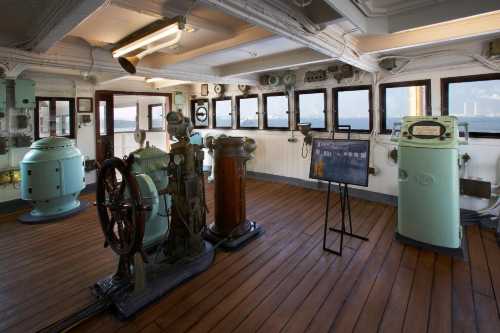Step Into the Golden Age at NYK Hikawa Maru 🚢✨ Ready to relive the romance of the high seas? The NYK Hikawa Maru is Yokohama’s hidden gem, a vintage Japanese luxury cruise ship docked right in Yamashita Park, overflowing with Art Deco details and tales of glamorous voyages past. If you love discovering unique slices of history, carve out a slow afternoon here for a truly immersive escape. 🛳️ Route & Must-dos: Start by strolling from Yamashita Park—the ship is impossible to miss! Hop aboard and explore the elegant passenger cabins, retro lounges, and the bridge for a peek at 1930s ocean travel. Picture yourself as a first-class passenger soaking in the view from the promenade deck. 📸 Top Photo Spots: - Shoot the ship’s iconic bow from the park for a classic skyline shot. - The restored first-class dining room offers vintage vibes for close-up snaps. - Bonus: Sunset over the bay from the main deck is pure “insta-worthy” magic. 🕘 Practical Tips: Open 10:00–16:30, Tuesday to Sunday (closed Mondays). Entry is super smooth mid-afternoon, plus you’ll miss the morning tour crowds. English info is available throughout the self exploring tour, but bring translation apps if you want to dig deep into the history. ⚠️ Precautions & Insights: Some narrow stairways and shipboard spaces aren’t wheelchair-friendly. Watch your step if you explore the engine room! The experience is best enjoyed slowly—don’t rush; this is a place to linger and savor the feeling. #Yokohama #CruiseHistory #NYKHikawaMaru #VintageTravel #HiddenGem
Scrivenshaft
Popular Trip Moments
Hammock Seats & Fluffy Pancakes in Yokohama! | 🕰️ Timeless Elegance at Lumière de Paris, Yokohama | 🌇 Hidden High-Rise Gem: mequ Lounge Café & Bar, Yokohama | ❄️ Cozy Winter Vibes at Blue Bottle Coffee, Minatomirai | 🍽 A Hidden Gem in Higashi-Totsuka — French Dining at Kyuuemontei | 🌊 Lunch with a View at Oriental Beach Yokohama | 🌿 Nature Walk in Yokohama | Yokohama Red Brick Warehouse Christmas Market | [Recommended spots in Yokohama] | [Kanagawa Prefecture] Cup Noodles Museum Yokohama: Fun for both adults and children | Yokohama | Japan's Most Underrated City | 🌉 Enjoy a panoramic view of Yokohama Port from Osanbashi Pier | Enjoy a food tour and exotic atmosphere in Yokohama Chinatown | Seaside stroll to enjoy Yamashita Park and the harbor scenery | Enjoying the Night Views and Urban Strolls in Minato Mirai | 🎨 The Renewed Yokohama Museum of Art | Enjoying history and modernity at Yokohama Red Brick Warehouse | Yokohama Bay Cruise: Stunning Views from the Sea | Enjoy a stylish stroll through Motomachi Shopping Street | Enjoy a moment at Harbor View Park in Kanagawa Prefecture | NYK Hikawamaru Exhibits | Yokohama Cruising | Cup Noodles Museum in Yokohama, Japan: An ideal choice for family travel | A Day in Yokohama: My Cultural Adventure | Discovering the Whimsical Moku Moku Waku Waku Yokohama Yo Yo | If you're looking for Christmas trees, head to Yokohama! The giant tree at Bay Quarter is a popular photo spot | [Kanagawa🇯🇵] Enjoy the sea and gourmet food with one ticket! Hayama Girls' Trip Ticket🚃✨ | [Kanagawa] A hidden gem cafe! | You can feel the atmosphere of the ancient capital while in Yokohama!
Recommended Attractions at Popular Destinations
Popular Attractions in Kuala Lumpur | Popular Attractions in Iguazu National Park(Argentina) | Popular Attractions in Walt Disney World Resort | Popular Attractions in Dubai | Popular Attractions in Paris | Popular Attractions in Los Angeles | Popular Attractions in Barcelona | Popular Attractions in Bangkok | Popular Attractions in Rome | Popular Attractions in London | Popular Attractions in Singapore | Popular Attractions in Osaka | Popular Attractions in New York | Popular Attractions in Zanzibar Island | Popular Attractions in Bali | Popular Attractions in Melbourne | Popular Attractions in Beijing | Popular Attractions in Shanghai | Popular Attractions in Sydney | Popular Attractions in Las Vegas | Popular Attractions in Tokyo | Popular Attractions in Chefchaouene | Popular Attractions in Kyoto | Popular Attractions in Phuket | Popular Attractions in West Lake | Popular Attractions in Chengdu | Popular Attractions in Florence | Popular Attractions in Madrid | Popular Attractions in Istanbul | Popular Attractions in Jungfrau Region
Popular Attractions
Qiantang River | Houshi Dock | Doumu Palace | Pavilion of High Mountain and Flowing Water | Red Gate Palace | House of the Xue Family | Cuihua Mountain·Qinling Zhongnanshan Unesco Global Geopark | Xian Banpo Museum | Big Wild Goose Pagoda | Huaqing Palace | Emperor Qinshihuang's Mausoleum Site Museum | Huguo Grain Official Temple | Shaanxi History Museum | Qinglong Temple | Xi'an City Wall | Khoo Kongsi | Chaiya Mangalaram Thai Buddhist Temple | Dianchi Lake | Dongpo Academy | Songtao Reservoir | Devlin Park | Mont César | Nicholson-Ford OHV Park | Vilinske jame | Al-Shohadaa Mousque | Khram Vozdvizheniya Kresta Gospodnya | Wira Bruk | Joachim Loop Trail | Football Stadium | Jafariya Masjid
Popular Restaurants in Yokohama
Shikitei | Araiya | Chikuyoutei Yokohama Sogo | KatsuRetsuan Bashamichi Main Store | Cafe Tosca | Sushi Choushimaru Hiyoshi | Sushiotowa | Ramen Mu | Azamino Ukai-tei | Liberty | MILANO | GRILL | Casa de Fujimori | Kadohei Tsuketen Soba | Wakana | Trattoria Bikorore Yokohama | Nadaman Yokohama-Branch | Megumi Suisan Mark Is Minato Mirai | Ko-No-Hana | Uemura'ya Yokohama Ramen kitchen | CAMBUSA | Sirius: SKY lounge | Shigorokusaikan | Ringer Hut Yokohama Konandai | Ningyocho Imahan Yokohama Takashimaya | Wangfujing Honten | 中国料理 驊騮「カリュウ」 | Iron Bay | Charcoal Grill green BASHAMICHI | Masago Saryo | Bishokumaimon Yokohama
Popular Ranked Lists
Popular Luxury Hotels in Shiojiri | Top 50 Must-Visit Restaurants in Rome | Top 10 Best Things to Do in Colombo | Top 20 Luxury Hotels near Bochum | Popular Premium Hotels in Narberth | Top 50 Must-Visit Restaurants in Nanjing | Popular Premium Hotels in Newquay | Top 10 Best Things to Do in Kanazawa | Popular Best Things to Do in Yixing | Top 50 Best Things to Do in Venice | Popular Luxury Hotels Near Swakopmund | Top 50 Best Things to Do in Buenos Aires | Top 50 Must-Visit Restaurants in Langkawi | Top 10 Best Things to Do in Jianshui | Top 50 Must-Visit Restaurants in Ho Chi Minh City | Popular Best Things to Do in Duyun | Top 50 Must-Visit Restaurants in Foshan | Popular Luxury Hotels in Kuala Nerus | Popular Premium Hotels in Aachen | Top 10 Luxury Hotels near Gateway | Top 50 Must-Visit Restaurants in Vienna | Top 10 Luxury Hotels near Boljoon | Top 50 Luxury Hotels near S'agaro | Popular Best Things to Do in Amman | Popular Premium Hotels in Norman | Top 50 Must-Visit Restaurants in Chaozhou | Top 50 Luxury Hotels near Beverley | Top 50 Must-Visit Restaurants in Dubai | Top 50 Must-Visit Restaurants in Guangzhou | Top 50 Must-Visit Restaurants in Taipei
About
Payment methods
Our partners
Copyright © 2025 Trip.com Travel Singapore Pte. Ltd. All rights reserved
Site Operator: Trip.com Travel Singapore Pte. Ltd.
Site Operator: Trip.com Travel Singapore Pte. Ltd.





















